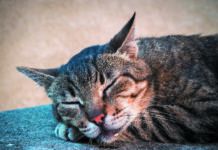Q. Recently, I noticed that my seven-year-old male cat, Bisco, was excessively grooming his hindquarters. When I investigated the site, I discovered a raw, red spot where he had licked the fur and skin off. The vet explained that Bisco had developed a “hot spot” and that these were fairly common in cats, particularly during the summer.
Fortunately, Bisco responded well to an antibiotic and treatment with prednisolone, but I am wondering how common this condition is in cats — I have heard about it frequently in dogs.
Roberta Klein
A. Dear Roberta: You are describing a very common problem: excessive grooming/licking over the hindquarters during summer and fall months. This is most likely caused by flea-allergic dermatitis (FAD) and it is the most common skin problem impacting cats.
Flea allergy dermatitis is actually different than just having fleas. As an analogy, it is painful for me if I am out in the yard and am stung by a bee. But some people are allergic to bees, and when stung, they need to go to a hospital. These people are allergic to bee stings.
Somewhat similarly, cats may be allergic to fleas. When a flea bites, it injects saliva into the cat’s skin and the allergic response is to the flea saliva. In fact, single injection of saliva (a single bite) can make an allergic cat itch for up to two weeks! This is different than just having fleas. Only those cats with allergic responses experience the severe itching response. Typically, FAD cats itch over the hindquarters. Some also experience itching down their hind legs, in the groin and along their spine.
The best treatment for FAD is to eliminate fleas. Your veterinarian can recommend an appropriate product that is best for your cat. As well, a short course of anti-allergic medicine (prednisolone) may be needed to stop the itch.
Michael Stone DVM, DACVIM
Clinical Assistant Professor
Cummings School of Veterinary Medicine at Tufts University



